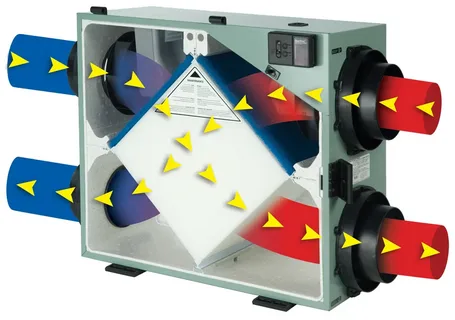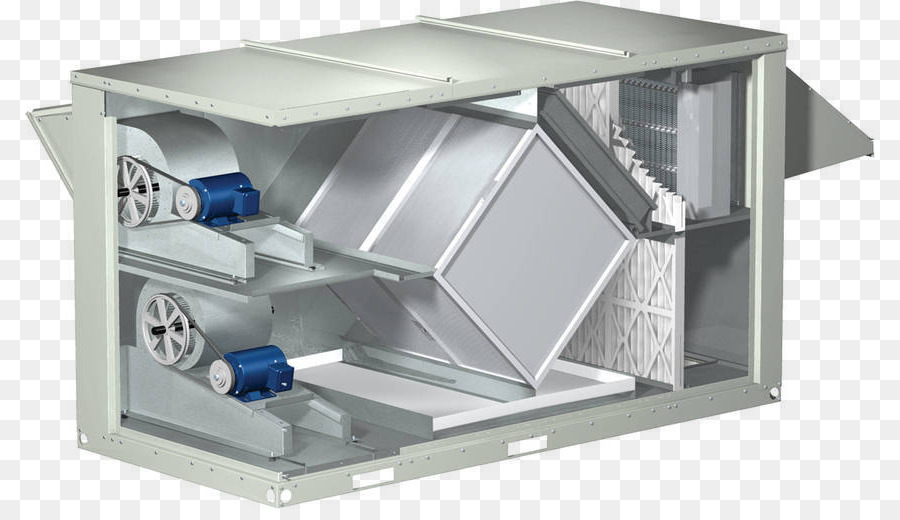Heat ventilation systems are becoming increasingly popular in homes and commercial buildings and with good reason. Heat ventilation systems provide efficient and effective ventilation while also helping to reduce energy consumption and associated costs. In this post, we will look at what heat recovery ventilation system is, how it works, and the various benefits it can offer. By the end of this article, you should better understand these systems and their many advantages.
What Is A Heat Ventilation System?
A heat recovery ventilation (HRV) system is a type of mechanical ventilation system that provides fresh air into a building while also improving indoor air quality and energy efficiency. Unlike traditional ventilation systems that waste heat by exhausting it outside, an HRV system uses heat recovery technology to recover heat from exhaust air and transfer it to incoming fresh air.
HRV systems are typically used in buildings with high air-tightness, such as energy-efficient homes and commercial buildings. By reducing the energy required to heat or cool the incoming air, HRV systems can significantly lower energy bills while improving indoor air quality.
HRV systems extract stale air from the building through a duct system and pass it over a heat exchanger. The heat exchanger recovers heat from the exhaust air and transfers it to the incoming fresh air. The fresh air is then distributed throughout the building through another duct system.
In addition to energy savings, HRV systems offer several benefits for indoor air quality. By continuously exchanging stale air for fresh air, HRV systems can reduce levels of indoor air pollutants, including volatile organic compounds (VOCs), carbon monoxide, and other harmful gases. This can improve the overall health and well-being of building occupants.
How Does A Heat Ventilation System Work?
A heat ventilation system works by removing stale indoor air and replacing it with fresh outdoor air while also recovering heat from the exhaust air before it is released outside.
The process begins with the ventilation unit, which contains two separate air streams: the supply air stream and the exhaust air stream. The stale indoor air is pulled out through ductwork and directed through the heat recovery core, designed to recover the heat from the outgoing air.
The recovered heat is then transferred to the incoming outdoor air stream, filtered before entering the home. This fresh air is circulated back into the house through separate ductwork, providing a constant flow of clean air. The system can also be designed to regulate the humidity level, as some heat ventilators are equipped with built-in humidity control features.
The heat ventilation system ensures that the air inside your home remains healthy and comfortable while reducing the energy required to heat or cool it, thus providing long-term energy savings. One of the key benefits of a heat ventilation system is improving indoor air quality. The constant flow of fresh air helps reduce the buildup of pollutants, such as allergens and volatile organic compounds, which can harm your health. In addition, the heat recovery from the exhaust air helps reduce the energy required to heat or cool your home, resulting in lower energy bills and reduced environmental impact.
Once you’ve chosen a system, it’s important to have it installed and maintained by a qualified professional. Proper installation and maintenance can help to ensure optimal performance and energy efficiency, as well as prolong the lifespan of the system.
Benefits of Using a Heat Recovery Ventilator
Using a heat recovery ventilator offers numerous benefits, making it an ideal choice for many homeowners. Here are some of the benefits of using a recovery ventilator:
Improved Indoor Air Quality: One of the main benefits of using a heat ventilator is that it improves indoor air quality. The system helps remove stale air and introduces fresh air into the house, keeping the air clean and fresh.
Energy Efficient: Heat recovery ventilators are designed to help reduce home energy consumption. The system recovers heat from the outgoing air, using it to preheat the incoming air, so the heating system doesn’t have to work as hard.
Cost-Effective: While the initial cost of installing a heat ventilator may seem high, it can save you money in the long run. By reducing energy consumption, the system helps lower energy bills.
Enhanced Comfort: You can enjoy a comfortable home environment with a heat ventilator. The system ensures a steady supply of fresh air and helps regulate the indoor temperature, reducing temperature fluctuations and drafts.
Reduced Condensation: Heat ventilators help reduce condensation buildup in the home. By introducing fresh air, the system helps reduce the humidity levels, reducing the risk of mould and mildew growth.
Types of Heat Ventilation Systems
Three main types of heat ventilation systems are available on the market today. Each system is designed to suit different applications and building sizes.
Passive Heat ventilation system
A passive heat ventilation system relies on natural air flows to supply and extract air from the building. The system incorporates vents in the walls or roof to provide natural ventilation. It works best in buildings with good exposure to wind or buildings located in windy areas.
Heat ventilation system with Heat Exchanger
This type of system is a more sophisticated version of the passive heat ventilation system. It features a heat exchanger which transfers the heat from the stale air to the fresh incoming air. The heat exchanger reduces the load on the heating and cooling systems, thus making it more energy-efficient.
Mechanical Heat ventilation system
A mechanical heat ventilation system uses fans to circulate air in and out of the building. The system features heat exchangers that extract the heat from the stale air before expiration. The recovered heat is then transferred to the fresh incoming air. Mechanical heat ventilation systems are highly effective at ventilating larger buildings.
When deciding which heat ventilation system to use, it is important to consider the size of your building, its location, and the amount of air exchange required.
It is worth noting that different types of heat exchangers can be used in these systems, including rotary, plate, and enthalpy heat exchangers. The type of heat exchanger used will depend on the specific needs of your building and budget.
Factors to Consider When Choosing an Energy Recovery Ventilator
When choosing an energy recovery ventilator (ERV) for your home or building, several important factors must be considered. Here are some of the most important:
Size: Choosing an ERV that is appropriately sized for your home or building is important. A system that is too small will not effectively ventilate your space, while one that is too large will waste energy and money.
Efficiency: Look for an ERV with a high-efficiency rating. This will ensure you get the most out of the system while keeping energy costs down.
Noise level: Some ERVs can be quite loud, so consider the noise level when choosing a system. Look for models that operate at a low noise level to minimize disturbance to your home or building.
Installation requirements: Ensure you understand the installation requirements for the ERV you choose. Some systems require ductwork or special installation procedures, so consult a professional to determine what is needed.
Maintenance: An ERV requires regular maintenance to ensure it functions properly like any mechanical system. Look for systems with easy-to-access filters and components for easy maintenance.
Price: Finally, consider the price of the ERV you are considering. While it may be tempting to choose a lower-cost system, keep in mind that higher-quality models will likely be more efficient and cost-effective in the long run.
Considering these factors, you can choose an energy ventilator that meets your needs and helps keep your home or building comfortable and healthy.
Installation and Maintenance of Heat Ventilation Systems
Installing a heat ventilation system can be complex, but a professional installer can help. It’s important to ensure the system is installed correctly to ensure maximum efficiency.
Maintenance of the system is also crucial to keep it running at its best. Filters should be cleaned or replaced regularly to prevent the buildup of dirt and debris. A professional should also inspect the system on an annual basis to ensure it is running efficiently.
Additionally, it’s important to keep the outside vents clear of snow and debris to ensure proper airflow. And finally, be sure to replace any damaged or worn-out parts to keep the system running smoothly.
By taking proper care of your heat ventilation system, you can ensure it continues to provide fresh, clean air to your home while saving you money on your energy bills.
The Bottom Line
Heat ventilation systems are becoming increasingly popular for their ability to efficiently and effectively ventilate a space while conserving energy. By extracting heat from stale, outgoing air and transferring it to incoming fresh air, these systems can improve indoor air quality while reducing energy bills.
When considering a heat ventilation system, it is important to consider the specific needs of your space and the different types of systems available. Professional installation and regular maintenance are also crucial for ensuring optimal performance.
A heat ventilation system can provide a valuable solution for ventilation needs, promoting comfort, health, and sustainability in any building.
| Other Good Articles to Read |
| Blogs Rain |
| Cme Blog Spot |
| Garcias Blogs |
| Yyc Blogs |
| Blogs-Hunt |
| Impact-Blog |
| Smarty Blogs |
| Ed Blog |
| Mo Blogs |
| Blogs Em |
| Blogs T |



